|
Specifications: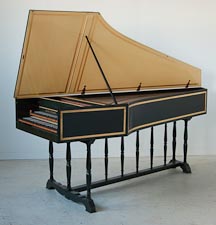
Range: 60 notes, five octaves less one semi-tone, FF-e''', non-transposing
Disposition: Upper manual 1 x 8'; lower manual 1 x 8', 1 x 4', buff stop; brass handstops and shove coupler
Dimensions: length 7' 11"; width 3'
Decor: case - dark green, gilded mouldings & bands; lid - dark green exterior, cream yellow interior with gilded mouldings & bands; carved-foot baluster stand - dark green.
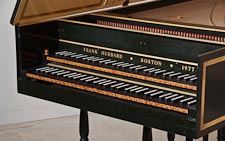 Keyboard: edge-rounded ebony naturals with 3 score marks, true boxwood arcades; ivory-capped sharp blocks of dark tropical hardwood (cocobolo?). Keyboard: edge-rounded ebony naturals with 3 score marks, true boxwood arcades; ivory-capped sharp blocks of dark tropical hardwood (cocobolo?).
Jacks: reproduction wood jacks (pear) and tongues (holly) with bottom adjusting screws, natural bristle return springs; registers and lower guides faced with punched leather; delrin plectra; cloth dampers.
Includes: canvas carrying cover, tools, maintenance supplies
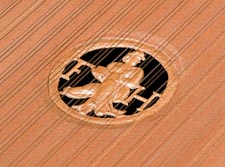 The case and wrestplank both show mild evidence of string-stress distortion. These effects are long-term and cumulative. While their presence is hardly surprising, the relatively modest extent displayed is quite heartening. There are gaps between the 8' hitchpin rail moulding and the case wall in the treble and bass. All repairs of this sort are included in the offering price. The case and wrestplank both show mild evidence of string-stress distortion. These effects are long-term and cumulative. While their presence is hardly surprising, the relatively modest extent displayed is quite heartening. There are gaps between the 8' hitchpin rail moulding and the case wall in the treble and bass. All repairs of this sort are included in the offering price.
It is clear that, for a portion of its life, the instrument has been maintained in conditions of high humidity. The soundboard is noticeably foxed in a few places and would benefit from a light cleaning in general. This and a wholesale restringing and revoicing are included in the offering price.
The original decision to fashion the bottom of the instrument from 'poplar' (Liriodendron Tulipifera) of extraordinary thickness has been a source of some grief for much of the life of the instrument. Seasonal growth and shrinkage of the bottom has resulted in some damage to the cheek-bentside joint near the bottom. This is admittedly unsightly; however, the instrument’s structure appears to remain as robust as similar instruments without similar damage. If the deficiencies of the lacquer finish prove sufficient to provoke a refinishing it would be advisable to replace the bottom entirely with another, less destructive part and repair the treble joint.
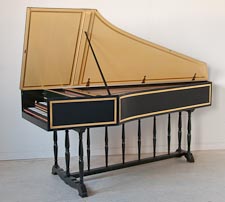 The lacquer finish has suffered from age, honest wear and other less common insults. Since it is entirely possible that the cost of repair to the finish (among other things, the gilding on the case would be entirely lost) may exceed the perceived increase in value, it has been decided to leave this to the discretion of the buyer. Hubbard no longer works in lacquer – this will have to be sub-contracted. The lacquer finish has suffered from age, honest wear and other less common insults. Since it is entirely possible that the cost of repair to the finish (among other things, the gilding on the case would be entirely lost) may exceed the perceived increase in value, it has been decided to leave this to the discretion of the buyer. Hubbard no longer works in lacquer – this will have to be sub-contracted.
The owner has maintained this instrument at its proper design pitch, a’=415 Hz, for its whole life. For many owners, however, the ability to play at modern pitch is the sine qua non of usefulness for such an instrument. The excess tension that would be caused by keeping a harpsichord of this design at modern pitch will decrease the service life to be expected. Changing the pitch of one string by a semitone (a difference in frequency of ~6%) results in about double a change of tension (~12%). Excess tension also serves to diminish the quantity and quality of sound the soundboard can transmit. In most cases the best solution to this problem is to make the instrument into a transposer. This would allow the instrument to remain pitched a half-tone lower, thus reducing the tension substantially while retaining the ability to play the instrument at modern pitch. Several schemes present themselves as possibilities, none wholly acceptable. It has been decided to leave the option open to a committed buyer.
Conclusion: The instrument is offered with the following repairs: 8' hitchpin rail moulding, soundboard cleaning & shimming, complete restringing, complete re-voicing with fresh plectra. The unresolved matters of the bottom and t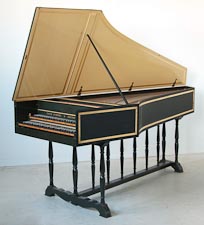 he damaged cheek-bentside joint do not currently affect the instrument’s function and it is probable that these repairs can be safely put off to a later time. Likewise, the instrument has definite issues with cosmetics but the losses and wear that are evident are largely confined to the top of the lid and do not in any manner interfere with its function. They either may be attended to immediately or left to discretion and the future availability of funds. Similarly, the issue of refashioning the instrument as a transposer may not be critical and has been left to the buyer's decision also. We will gladly discuss the possibilities for the further repair of this fine instrument with any interested parties. he damaged cheek-bentside joint do not currently affect the instrument’s function and it is probable that these repairs can be safely put off to a later time. Likewise, the instrument has definite issues with cosmetics but the losses and wear that are evident are largely confined to the top of the lid and do not in any manner interfere with its function. They either may be attended to immediately or left to discretion and the future availability of funds. Similarly, the issue of refashioning the instrument as a transposer may not be critical and has been left to the buyer's decision also. We will gladly discuss the possibilities for the further repair of this fine instrument with any interested parties.
Offering Price (EG-1) $15,000
|